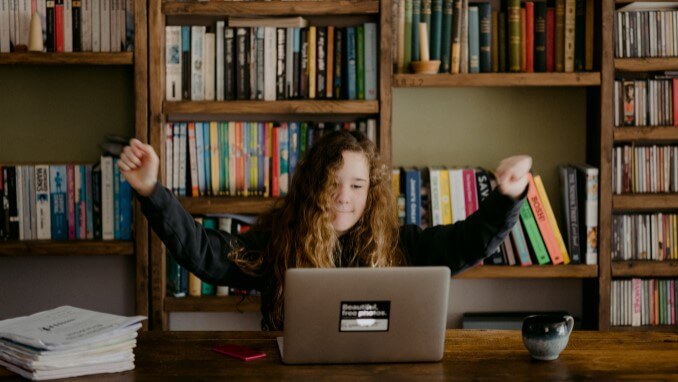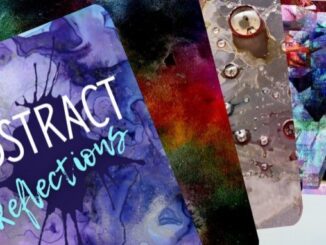
The great resignation
Business journals and companies worldwide are dealing with the ever changing demands of a workforce, struggling with the changing world of a pandemic, deciding that the way work has been done is no longer acceptable. Employers are clamoring for answers to an aging and dwindling workforce that is demanding a caring, flexible and sustainable work environment.
As a teacher of business, entrepreneurship and gaming, the end of the 2019-2020 school year was one that was unlike any in my 30+ year career. Moving through the 2020-2021 and now into the 2021-2022 school year, with remote and in-person learning methods, synchronous and asynchronous lessons, as Bob Dylan famously sang, “the times, they are a changin,” and in my view, for the better.
Students are not “resigning themselves” to the same old tired worksheets and paper tests and teacher-led methods of education of the past prior to the pandemic. Students, some working job(s) on the front lines to help their families while balancing their academics, and other relationships in the world during a pandemic, and their responsibilities to family and friends, wanted – no needed – projects and assessments of their knowledge that allowed them to express their feelings while receiving educationally
robust and engaging lessons.
What is unique and exhilarating about my teaching position is that not only do I teach (in person) at a small rural high school in the upper Hudson Valley of NYS, I utilize distance learning technologies for those with medical or other needs that prevent them from in person instruction. During the 2019-2020 and 2020-21 school years I taught students via distance learning technologies in eight different school districts up to 100 miles away.
Skills for teaching, building rapport, trust and engagement between all of my students is vitally important when presenting learning to students that are not all physically in the same room. Presenting to those in person students who have dealt with life altering events unprecedented in our lifetimes provides us with the ability to make education better.
Connections between work and school
Students needed (need) to see the deep and long lasting connections between work and school. These methods needed to deepen the cognitive connections, decrease the stressors of life and bring some fun and meaningful new ways of learning into their lives.
They needed games to take away some of monotony while learning concepts in new robust ways. Teaching a varied course load from college computer informatics, to college accounting, college business math and accounting to entrepreneurship and social media, game and game theory, my brain has to think in creative ways.
So why not use my love and passion for weaving gaming, digital storytelling and business together through the use of games, in tabletop or video versions, to enhance team building, social emotional skills and creativity?
During this and last school years, our entrepreneurship class utilizes the INCubatoredu curriculum from Uncharted Learning. Taking 9th – 12th graders from ideation to pitch, this curriculum builds the foundations of lean entrepreneurship concepts. However, getting a 9th grader to stay focused with this complex material and a 12th grader with Senioritis to show up and care can be daunting tasks for even the most experienced of teachers.
Introducing concepts such as sustainable development goals, local sourcing, responsible economic practices through role playing games and teamwork activities, brings a depth and breadth of knowledge to these young entrepreneurs. With a growing number of community mentors, we strive to not only learn, but give back to our local community.
Students are engaging in a paper tower building contest modeled on the Fluor Challenge https://www.sciencebuddies.org/fluor-challenge , and we are incorporating the units on ideation and team building to do social good in our community. This models donut economic theories, and introduces students to the UN 2030 Sustainable Development Goals. They work cooperatively and compete for the betterment of their world.

Thanksgiving is a time where those who have food insecurities can find additional stressors, so by collecting canned goods in which to accomplish this activity, students will learn about ideation and creation with limited resources, whilst helping those in our community and competing for good. (Prize is a donation to the community food bank in their name.)
Students will be using paper that is being recycled to accomplish this goal and the prize will be a write up on social media (done by students in the social media marketing class) and our school’s website with an additional donation made by a mentor in the community. Students will then be reflecting on this experience to help develop a business model canvas for their own business concept.
Games for Learning
College Accounting students complete “The Accounting Game – Basic Accounting Fresh from the Lemonade Stand” by Darrell Mullis and Judith Orloff to review the basics of financial accounting. By completing tasks in the creation of a fictional lemonade stand, students get to have fun and see the real world connections for their decision making.
Enhancing this game, students watch the Shark Tank episode and articles featuring young entrepreneur Mikaila Ulmer. This develops this game scenario into a discussion of social entrepreneurship, environmental science and taking an idea to fruition. Diverse voices are represented and students also make connections with our school’s environmental science class that has a working honey bee colony and produces consumer goods for our community.
In College Business Math, playing The Jackson 5’s song ABC and allowing students to play musical chairs to demonstrate permutations and combinations brought fun, movement and connections for students both in the physical classroom space or attending remotely. Playing bingo to reinforce combinations and permutation work as well as playing a dice rolling game can easily take rote skills and transform them into fun learning activities that “stick.” Creating budgets through playing the board game Life and researching the true cost of the financial decisions made through playing the game choices develops real world skills.
Students also play charades in Social Media Marketing and will be creating QR codes with links to games to reinforce community building, collaboration and kindness within our school and community at large. They often create jeopardy like games to reinforce vocabulary and utilize TikTok dance and song challenges to create school community social media posts on topics of importance; strengthening their skills in social media.
In 2019, I learned about the work that my friend and mentor, Paul Davarsi, Ph.D was engaged with in partnership with iThrive Games, a non-profit organization committed to “teens, games, and social and emotional learning” on the game-based humanities unit, Museum of Me , I soon realized that Museum of Me had rigorous content along with the social emotional learning supports embedded within, and immediately I knew that I wanted to utilize this with my Video Game Design Essentials students.
Our teamwork and the ability to collaborate was put to the test while thrust into the emergency remote learning situation brought on by COVID-19 in March 2019 as this course is a half-year course that normally runs from the end of January to June.
My job to support my students’ learning took on a whole new meaning, and making sure that they were ok became my first priority. Virtual classroom meetings were challenging due to scheduling conflicts, so personal outreach by me and my colleagues at the other schools became more important than ever.
Students truly needed to know that we cared before they cared about what we knew. The Museum of Me curricular unit is built on a model that has the students play through the video game “What Remains of Edith Finch.” The unit guides teachers to use a “hot seat” model where one student at a time plays while the rest of the class observes. That was tricky in our time-compressed virtual learning environment, but I was determined to find a way to use it. I knew that asking students to purchase individual copies of the game was a deal-breaker for most of my students struggling financially during this time.
How can I deliver this content? My students deserve the very best, and the solution came to me while watching my then 13-year-old son view YouTube videos of gameplay! Playthrough videos! (For those of you unfamiliar with the term playthrough – it is a video gamer recording a video game being played live with a running commentary by the player.)
So I searched for playthroughs of “What Remains of Edith Finch” and hit a treasure trove of video content. Once I figured out access, I moved onto making sure students had choices for demonstrating learning. Choice is a vital portion of the students’ capstone of their learning and most learning assessments that I undertake with my students involve learner choice.

Their choices (along with other recommended readings and questions from the Museum
of Me unit), were as follows:
- Analyze What Remains of Edith Finch playthroughs from the standpoint of the technical elements of video game design. Research other reviews. Locate one positive and one negative review and come up with your own conclusions about the quality of the game based on current and prior learning.
- Create your own version of a storyboard (template and instruction provided to students in presentation software MS PowerPoint/Google Slides) based on the What Remains of Edith Finch introduction playthroughs. Include the game elements, motions, mechanics, and flow. Attach your storyboard template to the main project assignment.
- Read the poem We Wear the Mask by Paul Laurence Dunbar and watch the playthroughs, then write YOUR version of an introductory game narrative in the style of What Remains of Edith Finch using one or more of the following as inspiration: an object in your home, your thoughts on the COVID-19 lockdown mask requirements, your feelings about quarantine, how video games have kept you connected, and/or your experiences doing your classes online through video conference. This may be completed as a word processed document or as a video recording.
Some quotes from student work:
“My object important to me would be any picture of my family.”
“Going outside with masks, I feel a strange presence like we don’t fit in like the characters in the game.”
“It’s a game about what it feels like to be humbled. We all feel this now.”
“Some (parts of the game) are quite dark and others very calm and peaceful but it still gives you a sense of mystery and makes you crave to see the ending of each one.”
Wow! These direct responses from student work show engaged, thoughtful and mature commentary from a cross-section of students from very different socio-economic, racial and geographic backgrounds. They not only demonstrate a deep understanding of their knowledge of the concepts, but also a personal connection.
Students shared with me privately that using the playthroughs was helpful because if they had had to analyze the gameplay of a new game it would have been very stressful at that time. Most students had never played a video game in the creative style of What Remains of Edith Finch, so the exposure intrigued them and made them want to explore more games of this type.
Hoping to use the Museum of Me curriculum and other game-based lessons with my students this year in more detail, I strongly suggest that teachers think about not only using direct game play to engage learners, but also using video game playthroughs to involve and create an atmosphere of enrichment and deeper levels of social and emotional engagement with your content.
Today’s students are used to watching videos of others playing games as a way to learn and be exposed to new concepts, and tapping into that learning approach will bring great results. Playthroughs are a great way to get students analyzing and writing, while making personal connections to their lives and experiences.
So be it a traditional well known board game, a fun building challenge, a physical game, or video game playthroughs; games enhance students’ emotional connectedness to the content, deepen cognitive and social emotional learning and just make learning fun.
As the present now
Will later be past
The order is rapidly fadin’
And the first one now
Will later be last
For the times they are a-changin’
Shall we play a game?
- Games, Business and Changing Times - 12th November 2021
- Entrepreneurial Ludic Learning - 17th February 2020





Well Done!
Excellent article Kathy! Thank you for sharing what you are doing in the classroom. It’s clear that you are creative, proactive and caring for your students. They are lucky to have you as their teacher!
Awesome! Bringing those games from the classroom to the staff room can only result in more creative solutions to this planet’s pressing issues
Awesome job buddy and I miss ya.Loved the little chats we had in the hallways on music and assorted other things like politics…”The special Hell for Engineers,Architects,and Designers”,and dealing with job hierarchy,lol! Wish the best for you and keep on trucking!
Schubbs!! Thank you for reading my work and replying, it means a lot. Hope “retirement” is treating you well. Happy Holidays!